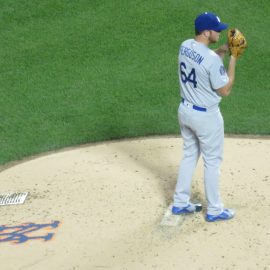Among other things, a lot of the discussion surrounding the Pittsburgh Pirates for the first half of the season has been about their pitching philosophy.
In an era where the league has focused more heavily on off-speed and breaking pitches while reducing the reliance on fastballs, the Pittsburgh Pirates have seemingly gone in the other direction, upping their usage of fastballs and, subsequently, reducing their reliance on off-speed stuff.
While much of the conversation has been limited to a few examples of pitchers, like Gerrit Cole’s change in approach and ensuing success, this is not sufficient proof. For every Cole there could be any number of other pitchers who tried to make a similar adjustment, found no success, and either returned to their old ways or washed out of the league and thus fail to grab the headlines.
In PART 1 OF THIS SERIES, I derived a way of looking at this problem of pitch selection in the specific and quantifiable context of actual displayed ability, rather than a qualitative approach of simply observing one pitcher and assuming others can fit into their mold.
We’ll be leveraging a mathematical tool known as game theory to find more efficient pitch selection. The “game” in game theory is defined in about as general a sense as possible; a game is simply an interaction between two or more individuals or “players” where each player has a choice which impacts the payoff or reward they receive. In our case, the game is defined as the interaction between the pitcher and the batter, where the pitcher has a choice over what pitch they throw and the batter has a choice over if they swing at the pitch or not.
The payoffs to each player are dependent on what the other player chooses to do; for instance, depending on what pitch is thrown, the batter may be better or worse off by swinging at it and the pitcher may throw a particular kind of pitch based on his belief about the batters preference to swing or not at that next pitch. If you’re interested in the particulars of how these payoffs are derived, part 1 contains that math.
A key note is that the numbers in the payoff matrices below are the average run value of each pitch, so all of the suggestions or eliminations of strategies are “on average”. Several times I will refer to a “strategy” or pitch as being “dominated” and thus should be eliminated from the pitcher’s arsenal, what this means is that the pitch should be used significantly less. Every time you see that suggestion of eliminating a pitch, mentally throw in an “on average” at the end to get a more realistic application of what I mean.
So let’s look at the Pirates’ starters.
Trevor Williams
We’ll start off with Trevor Williams, as he presents the easiest case to solve. First off here is his pitch mix (leaving out a two-seamer and curve, which are likely just a result of Statcast’s algorithm, not a decision by Williams)
The way to read it is that if Williams choses to throw a four-seam fastball and the batter chooses not to swing, Williams gets a payoff of 0.040 runs and the batter receives a payoff of -0.040 runs on average. Were the batter to choose to swing instead, Williams would have received a payoff of -0.032 runs and the batter gets 0.032 runs on average, and so on for every combination of pitcher and batter choices.
You might have noticed that Williams’ payoffs when the batter swings are always negative, and when they elect to not swing, Williams’ payoffs are generally positive. Intuitively, these payoffs make sense, when a batter is swinging the bat they can generate hits and knock in runs meaning a negative value for the pitcher, when the batter does not swing, their only hope for a positive offensive outcome is a walk, and allow the pitcher to take value from them by racking up free strikes.
That being said, not having a single pitch the Williams can generate positive run value on a batter’s swing is a bit of a problem. Keep in mind this is on average, so batters shouldn’t literally always swing, but they should on average. If you look at the batter’s payoffs, regardless of pitch thrown, the batter is always better off swinging.
Something interesting happens when we look at the payoffs relative to one another; William’s fastball carries a higher payoff than his changeup or sinker, regardless of the Batter’s choice to swing or not. In game theory terminology, this means that the change and sinker are dominated strategies, or that Williams is, on average, better off going electing to throw his four-seamer rather than either of those two pitches. Williams’ four-seamer is just a more effective pitch. In this sense Williams is acting quite rationally by throwing the four-seam fastball at the highest rate of any starter on the team; it is an effective pitch for him.
Something that is more interesting is something that has been developing since I began researching this topic at the beginning of the season. William’s slider is evolving into a more and more effective pitch.
When I first created William’s payoff matrix, his four-seamer dominated all of his other pitches, making him one dimensional as deviating to any other pitch carried a worse payoff for him. This largely explained why Williams was throwing his four-seamer 1 in every 2 pitches, he did not have a better option. However, as his payoffs stand now, the slider is his best option against a swing while his four-seamer is best against not swinging. This is a relatively recent development for Williams, so it will be interesting to see if Williams reduces his reliance on the fastball in favor for a now effective slider.
This is also an extremely important development for Williams as a starter. Prior to the slider’s development, Williams was one dimensional as he could not credibly threaten the batters with having to see another type of pitch, since he was only making himself worse off. Batters knew either quantitatively through a process like this, or qualitatively through facing him, that Williams’ other pitches weren’t effective. What that resulted in was batters sitting on a fastball in the zone and swinging at them when they get them, which they got roughly once every two pitches. Seeing if Williams can decrease his fastball reliance in favor of an increased slider usage will be a story to follow in the second half.
One other recommendation is that Williams should stop throwing the changeup, or at the very least limit its usage significantly. The change is effectively of zero or negative run value and is dominated by any other pitch that Williams throws. Similarly his changeup carries the lowest called and swinging strike rates, implying that it doesn’t do much to fool batters. This runs counter to the pitching strategy that Williams has used so far this season, which has been to up the changeup’s usage from 10 percent last season to 14 percent this season.
Jameson Taillon
While Taillon has a similar problem to Williams in that batters are always better off swinging, he has an obvious advantage in that he can throw both his curveball for positive run values when batters swing. This means that Taillon can mix his quality pitches and the threat of that mixing means batters don’t know what pitch is headed their way.
In terms of dominated strategies, Taillon’s two-seamer is strictly dominated by his four-seamer. In the situations where Taillon wants to throw his two seamer, by deviating to the four-seamer or using the “lower-ceiling-higher-floor” valued slider and curve, Taillion could improve his overall outcomes by a few fractions of a run per pitch. This means that Taillon should be upping his usage of four-seam fastballs, relative to his two seam usage.
While his changeup is also dominated by his four-seamer, meaning he always has a higher payoff going for the FF instead, I’m less willing to recommend abandoning it like with Williams. In Taillon’s case, the fact that it can be of positive run value when batters aren’t swinging, in addition to the fact that it is used sparingly, just 7 percent of the time, means Taillion is using in specific situations, rather than as a key weapon like Williams.
What I found to be perhaps the most interesting thing about Taillon’s results is that, despite the excitement surrounding his new slider, his curveball is still his dominant breaking ball. Regardless of the batter’s choice of swinging, Taillon is better off throwing the curve over the slider. In fact, even Taillon’s four-seam fastball still dominates the slider. That being said, I certainly wouldn’t advocate Taillon shelving the slider yet, it is still a new weapon he is developing and is a good secondary pitch to his four-seam/curveball primary pitches.
In terms of a recommended strategy for Taillion, he needs to keep doing what he has been doing over the last several games. Since his introduction of the slider as a serious pitch against the Cardinals in late May, Taillon has thrown his two fastballs a combined 52 percent of the time, down 10 percent from his season average, his slider 24 percent of the time, his curve 19, and his change 5 percent. While the payoffs would recommend he throw his curve a bit more and the slider a bit less, since the debut of the pitch, when he understandably used it particularly often, his curveball usage has risen, peaking at 34 percent in his last start before the break.
The other encouraging thing is that the addition of the slider has even further limited Taillon’s changeup usage. In all but one of his starts since the introduction of the slider, Taillon has limited his changeup usage to 6 percent or less, meaning he is largely replacing his weakest pitch when introducing his slider, rather than at the expense of his other more effective pitches. Overall this seems to be a very efficient pitch mix for Taillon; over the 6 games since he has made that change, he posted a 3.29 ERA and a 3.09 FIP.
Ivan Nova
One of the first things you may notice is that Nova’s curveball one of his best pitches this season, generating positive run value regardless of the batter’s choice to swing. There is an additional factor that, unlike Williams and Taillon, batters facing Nova don’t have a pure strategy to swing. While with the FF, FT, and CH, batter’s prefer to swing, when it comes to the CU, the batter would rather hold his swing.
One of the first things you may notice is that Nova’s curveball one of his best pitches this season, generating positive run value regardless of the batter’s choice to swing. There is an additional factor that, unlike Williams and Taillon, batters facing Nova don’t have a pure strategy to swing. While with the FF, FT, and CH, batter’s prefer to swing, when it comes to the CU, the batter would rather hold his swing.
What that means is that it takes away the pure strategy of always swinging (on average) against Nova’s pitches. If batters are more likely to keep the bat on their shoulder to avoid looking silly against Nova’s curve, it gives Nova the opportunity to get either of his fastballs over for called strikes. Furthermore, no one pitch dominates any of the others against both of the batters strategies, meaning batters really have little idea of what is coming their way on any given pitch. This allows Nova a fair amount of discretion when selecting a pitch mixture as each pitch can be effective in particular situations.
Since Nova returned from the DL on June 10th, he upped his curveball usage from 18.6 percent pre-DL to 22.5 percent post-DL while his fastball usage dropped from 70 percent to 64 percent respectively; seemingly showing he is moving toward greater usage of his curveball to set up his fastballs. The impact on the field has been stark; Nova’s pre-DL strategy resulted in a 4.96 ERA, while his post-DL strategy of slightly more curveball usage and fewer fastballs resulted in a 3.51 ERA.
One thing to note is that Nova’s two-seamer is either his most or least effective pitch, depending on the batter’s choice. If he continues to use it at the elevated rate he is using it at, he is increasing his variation in performance, meaning he is more likely to have very good and very bad games and less likely to be in the middle. That isn’t necessarily a bad thing, when things are going well it’s great, however if he wants to be more consistent, he might elect to throw more four-seamers to reduce that variance.
Come back tomorrow for Part 3, in which I will review Joe Musgrove, Chad Kuhl and Nick Kingham.
Add The Sports Daily to your Google News Feed!













